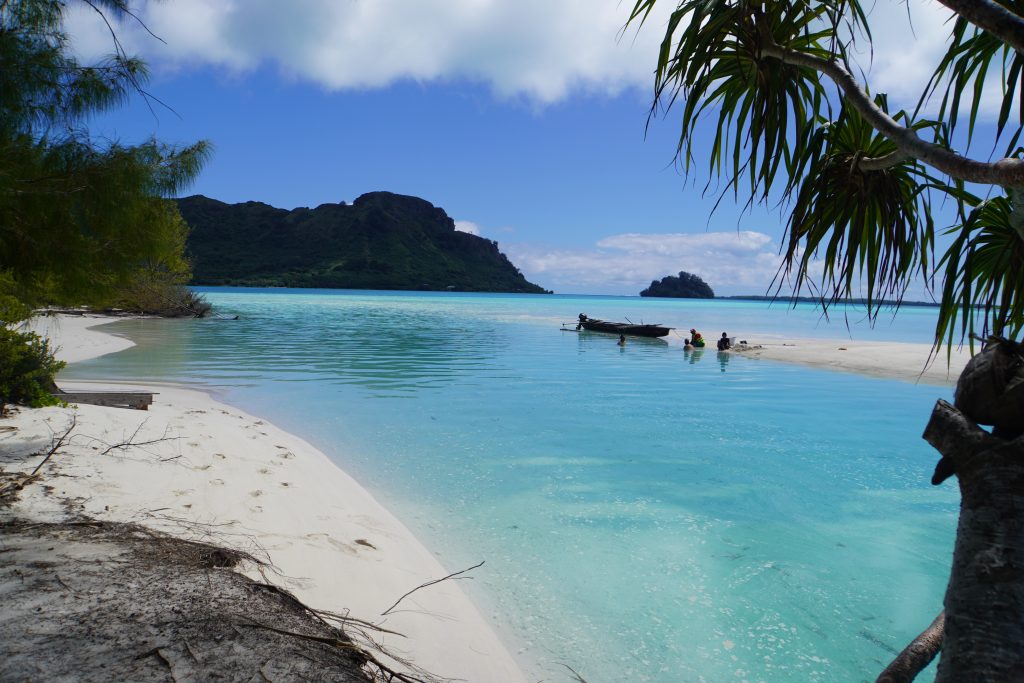Wind and waves were kind to us on our leg south from Tahanea: 3 days of broad reaching in 12-20 knots past Tahiti to Raivavai. The Austral group is comprised of 6 islands: Rapa in the far SE corner, Raivavae, Tubuai, Rurutu, Rimatara, and Maria in the far west. It would have been interesting to visit all of these islands – especially Rapa – since they get so few visiting yachts. In hind-sight, we would have had plenty of time to do so, but we expected to pick up Brother John (Stiggelbout) in Tubuai in early October and (hopefully) sail shortly thereafter for New Zealand. November 1 is the official start of the South Pacific hurricane season so we were feeling a bit pressed to move southwest as soon as John arrived. More on this sordid tale later…
We landed at Rairua Town on spectacular Raivavae on September 30 where the Gendarmes were among the first to welcome us to their quiet island. Of course, they wanted to see our passport stamps and COVID entry permit before sharing tips for enjoying the island. We were concerned that the locals might be inimical towards visitors (who might bring COVID to their community) but were relieved to find a cordial welcome everywhere.
Raivavae is very much like the Gambier group’s main island of Mangareva. One principle village spread out along a short stretch of perimeter ring road. The island is circled by a fringing reef with only a single navigable pass on the NW side. The supply ship arrives every two weeks or so bringing fresh and frozen goods, fuel, and building materials along with other supplies too heavy to deliver via the twice-weekly flights from Papeete (Tahiti). Ravavae is much smaller than Mangareva. On our rental bikes, we completed the ring road circuit in a few hours – including lunch and snack stops. With its sharp volcanic peaks, the island has arguably been called the most beautiful island in the South Pacific, a smaller version of Bora Bora.
We spent 10 days discovering the magic of Raivavae. Finding fresh fruits and vegetables proved rather difficult. Local shops (Magazins) carry only packaged goods, and sometimes frozen meats. For freshies, we learned to “demendez quel-q’un.” Ask around. We found a few Austral Islanders with vegetable gardens (mostly cabbage and carrots) willing to give but not sell from their gardens. We were successful buying pomplemouse (grapefruit), bananas, and papayas from Marie, a local opportunist who knows that cruisers crave freshies.
There really isn’t much to do on Raivavae, but what the island does offer is splendid. A rental bike ride around the island and over the traverse roads was a great way to find the small shops for replenishing our stores. A must-do hike to the top of Mt. Hiro rewarded Cindy with scores of breath-taking photos of the reef, lagoon, and myriad valleys of the island. In the south lagoon lies Ile Vaimanu and the “picine”. Viamanu is a stunningly gorgeous white sand beach with a natural multi-hued turquoise salt water pool. Navigating within the lagoon demanded vigilance on the bow looking out for coral heads (bommies) hungry for bottom paint. At the far east end of the island, we had to thread Pazzo through a series of closely spaced reefs in order to reach deeper water in the south lagoon.
There are a handful of Pensions de Famille on the Island, but no rental cars, taxis, or ubers. We found only one small restaurant. Visitors arrive at the tiny airport and are met by their Pension. In normal times, locals are happy to pick up hitch-hikers, but COVID put an end to that. So we walked. Everywhere. For our hike to the top of Mt. Hiro, we first walked 1 ½ hours to the trail head, then 4 hours round trip to the peak, and another 1 ½ hour walk back to the anchorage! Whew! We found a few artisans along our wanderings, including Tamara who specializes in shell and pearl jewelry. Cindy engaged Tamara (actually her daughter) to drill her Gambier pearls and string them into a bracelet. Happy (belated) anniversary Cindy!
We had planned to sail west to Tubuai to meet John’s flight from Papeete on October 17 but the weather forecast called for fresh northerly winds on the days leading to John’s arrival. Tubuai’s harbor on the north coast is exposed to north wind and swell as the fringing reef is quite low. High tide swells sweep right into the anchorage. So we abandoned plan A and sailed for Tahiti ahead of the northerly breeze.
